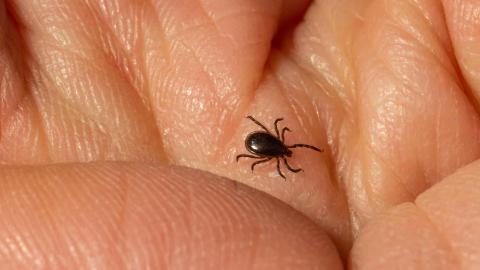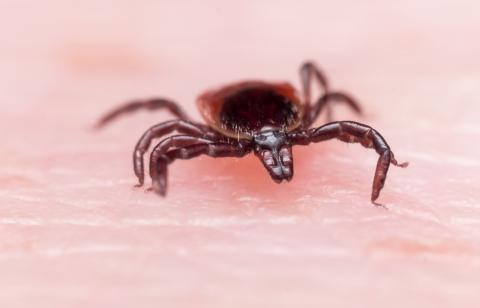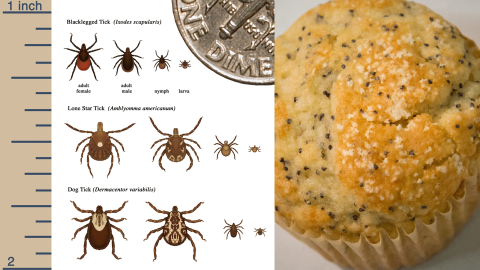Understanding and monitoring for tick-borne diseases
Tick-borne diseases are a growing concern worldwide, particularly in the United States, where the number of reported cases has been steadily increasing in recent years. These diseases are caused by a variety of pathogens, including bacteria, viruses, and parasites, which are transmitted to humans and animals through the bite of infected ticks. As ticks thrive in various environments and are known for their capacity to carry multiple pathogens simultaneously, it is crucial to understand the different tick-borne diseases and their impact on public health.

The deer tick (Ixodes scapularis), also known as the black-legged tick, is a common carrier of Lyme disease.
One of the most well-known tick-borne diseases is Lyme disease, caused by the bacterium Borrelia burgdorferi, which is primarily transmitted by the black-legged tick (Ixodes scapularis) in the United States. Other common tick-borne diseases include Rocky Mountain spotted fever, anaplasmosis, and babesiosis. These diseases can result in a wide range of symptoms, from mild to severe, and in some cases, can even be fatal if left untreated. Early diagnosis and timely treatment are essential to prevent long-term complications and control the spread of tick-borne diseases.
Key Takeaways
- Tick-borne diseases are a growing concern, particularly in the United States, due to their increasing prevalence and varied impacts on public health.
- Early diagnosis and appropriate treatment are crucial in managing tick-borne diseases, as they can cause severe health complications if left untreated.
- Preventative measures, including personal protection and environmental control, play a vital role in reducing the risk of tick-borne diseases and limiting their spread.
Understanding Tick Borne Diseases

Close up image of the American dog tick crawling on a leaf.
Characteristics and Types of Ticks
Ticks are small, blood-sucking arthropods that are known carriers and transmitters of various diseases. These parasites primarily feed on the blood of mammals, birds, and reptiles. Ticks can be classified into two main families: Ixodidae (hard ticks) and Argasidae (soft ticks). Hard ticks have a tough, shield-like plate on their backs, while soft ticks lack this feature. Both types can transmit diseases, but hard ticks are more commonly associated with tick-borne diseases in humans.
Common Tickborne Diseases in the United States
There are several tick-borne diseases present in the United States, and it is essential to be aware of their symptoms, treatments, and prevention methods:
-
Lyme disease: Caused by the bacterium Borrelia burgdorferi, Lyme disease is the most common tick-borne disease in the United States. It is primarily transmitted by the black-legged tick, also known as the deer tick. Symptoms include fever, fatigue, headache, muscle and joint aches, and swollen lymph nodes. If left untreated, it may cause severe health complications. Learn more about Lyme disease.
-
Rocky Mountain spotted fever: This serious illness is caused by the bacterium Rickettsia rickettsii. It is primarily transmitted by the American dog tick, the Rocky Mountain wood tick, and the brown dog tick. Symptoms include fever, headache, abdominal pain, vomiting, and muscle pain. In severe cases, it can lead to kidney failure and even death if not treated promptly. Find more information on Rocky Mountain spotted fever.
-
Anaplasmosis: Caused by the bacterium Anaplasma phagocytophilum, anaplasmosis is transmitted by the black-legged tick and the western black-legged tick. Symptoms include fever, headache, muscle pain, and sometimes rash. It can be treated effectively with antibiotics. Discover more about anaplasmosis.
-
Babesiosis: This disease is caused by microscopic parasites that infect red blood cells, typically Babesia microti. It is transmitted by the black-legged tick. Symptoms include fever, chills, sweats, headache, body aches, and fatigue. In some cases, it can be life-threatening, especially in immunocompromised individuals. Read more on babesiosis.
-
Ehrlichiosis: Caused by the bacteria from the Ehrlichia genus, ehrlichiosis is transmitted mainly through the lone star tick. Symptoms include fever, headache, fatigue, and muscle aches. Like most other tick-borne diseases, it can also be effectively treated with antibiotics. Find additional information on ehrlichiosis.
-
Tularemia: Also known as rabbit fever, tularemia is caused by the bacterium Francisella tularensis. It is transmitted by various ticks, including the American dog tick, the wood tick, and the lone star tick. Symptoms include fever, skin ulcers, and swollen lymph glands. Antibiotics can typically treat this disease effectively. Explore more about tularemia.
It is crucial for individuals to utilize preventive measures, such as wearing long-sleeved clothing and using insect repellents, to minimize the risk of tick bites and tick-borne diseases.
Symptoms and Diagnosis

Close up image of the blacklegged tick, also known as the deer tick, crawling on skin.
Early Symptoms and Signs
Tick-borne diseases can present a variety of early symptoms, making them difficult to diagnose in their initial stages. Common early symptoms include fever, headache, chills, fatigue, aches, joint pain, and muscle aches—all of which resemble flu-like symptoms. In many cases, a tick bite precedes the onset of symptoms; however, some patients may not recall being bitten.
Another common early symptom is a rash that develops near the site of the tick bite. The appearance of rashes can vary depending on the specific tick-borne disease at play. For example, Lyme disease often causes a characteristic "bull's-eye" rash known as erythema migrans. It's important to note that not all tick-borne diseases cause rashes, and not all patients will develop a rash after being bitten.
In addition to the aforementioned symptoms, tick-borne diseases may also cause nausea and vomiting in some cases. However, respiratory and gastrointestinal symptoms are less common and may point to an alternative diagnosis when prominent.
Medical Diagnosis Methods
Diagnosing tick-borne diseases often requires a combination of clinical observations and laboratory tests. A medical professional will consider a patient's history of tick exposure, geographical location, and presenting symptoms to form an initial diagnosis.
Laboratory tests are crucial for confirming or ruling out tick-borne diseases. These tests may include serological tests to detect the presence of antibodies, molecular tests to identify the DNA or RNA of the pathogens, and microscopy to visually identify the pathogens in blood samples. Improvement in molecular and immunological detection methods has significantly enhanced the accuracy of diagnosing tick-borne diseases.
It is important to diagnose and treat tick-borne diseases early, as timely intervention can prevent complications and long-term health issues. If you suspect you have been bitten by a tick and are experiencing symptoms, it is crucial to consult a healthcare professional for proper evaluation and treatment.
Epidemiology and Impact

Regional Prevalence
Tick-borne diseases are a significant concern in many U.S. regions, including New England. Proper surveillance and monitoring are crucial to understanding tick populations and the pathogens they carry. The University of New Hampshire's College of Life Sciences and Agriculture has taken an active role in addressing this issue, spearheading a multi-university tick surveillance system project to combat tick-borne diseases in the area. Thanks to a grant from the U.S. Geological Survey, researchers from UNH's NH Veterinary Diagnostic Lab, Hubbard Center for Genome Studies and Research Computing Center are collaborating with scientists from the University of Vermont and the University of Maine to develop comprehensive strategies that encompass various aspects of tick and tick-borne disease surveillance across Northern New England. These strategies include studying tick activity, tick abundance, and identifying pathogens that ticks carry.
As part of this initiative, researchers will collect data through different methods, such as field sampling, laboratory analysis, and public collaboration. By engaging communities and encouraging citizen science, valuable data can be gathered regarding human exposure to ticks and potential infections. This information helps researchers identify high-risk areas and develop targeted interventions to minimize the spread of tick-borne diseases.
In addition to field data collection, laboratory analysis is essential to understand the pathogens that ticks carry. By analyzing tick specimens, researchers can identify the presence of disease-causing agents, such as bacteria and viruses. This information is vital for developing effective prevention and control measures for tick-borne diseases.
Overall, tick and tick-borne disease monitoring in Northern New England is a crucial and collaborative effort, involving various institutions and the public. Through these combined efforts, scientists and public health officials continue working towards better understanding, prevention, and control of tick-borne diseases in the region.
Public Health Impact
According to the Centers for Disease Control (CDC), the incidence of tick-borne diseases has been on the rise. Deer ticks are responsible for transmitting various pathogens, such as the ones causing Lyme disease, Powassan virus, and other serious illnesses.
Some significant consequences of these diseases include:
- Lyme disease: Affects approximately 300,000 people each year in the United States. Symptoms include fever, fatigue, headache, muscle and joint aches, swollen lymph nodes, and the characteristic skin rash known as erythema migrans2.
- Powassan virus: A rare but potentially severe tick-borne illness with symptoms such as fever, headache, vomiting, weakness, confusion, seizures, and memory loss3.
The CDC emphasizes the importance of prevention measures against tick bites, both for people and their pets, to reduce the public health impact of these diseases4. Increased surveillance and reporting of tick populations and tick-borne diseases will also aid in controlling their spread and informing more effective prevention strategies.
Footnotes
-
Centers for Disease Control and Prevention. (2019). Geographic distribution of ticks that bite humans. https://www.cdc.gov/ticks/geographic_distribution.html ?
-
Centers for Disease Control and Prevention. (2021). Lyme disease: Signs and symptoms. https://www.cdc.gov/lyme/signs_symptoms/index.html ?
-
Centers for Disease Control and Prevention. (2019). Powassan virus: Symptoms, Diagnosis, and Treatment. https://www.cdc.gov/powassan/symptoms.html ?
-
Centers for Disease Control and Prevention. (2020). Preventing tick bites. https://www.cdc.gov/ticks/avoid/on_people.html ?